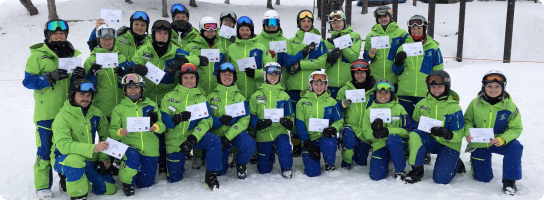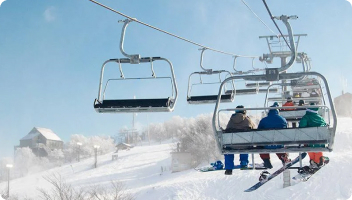Gear for Backcountry Skiing and Snowboarding
Heading out into the backcountry requires quite a lot of additional preparation as compared to resort skiing. In particular, your gear is crucial for your safety and enjoyment.
You need to remember that, out in the backcountry, you are going to need to be self-sufficient and you are responsible for your own decisions.
Essential items
Avalanche Transceiver
The transceiver is an essential tool to help locate someone who has been buried in an avalanche. Should a person be caught in an avalanche and buried, the others in the group can switch their transceivers to receive in order to pick up the signal and locate the buried person.
Shovel
A backcountry shovel will usually detach into two pieces for easier transport. A shovel will obviously help you dig more quickly should you need to perform a rescue. After an avalanche, snow sets like concrete, so a shovel is critical to remove the snow quickly. A snow saw can also be carried to move snow more easily, and if you are performing column tests for avalanches.
Probe
The probe will help you locate a buried person when you are within a few metres, after having honed in using the transceiver. The probe pinpoints the location of the buried person by jabbing the probe into the snow. This saves time as you should then know precisely where to dig.
Emergency blanket
An emergency blanket retains heat. It looks similar to aluminium foil and will assist in case you get trapped overnight. If you are caught overnight, you will want to create an emergency snow shelter (https://gearpatrol.com/2018/12/14/how-to-build-a-snow-shelter/) and the blanket will help you to survive the night.
Skis with touring bindings
Backcountry touring skis are, in general, built a little lighter for ease when travelling long distances. However, you can use any skis you want. The important thing is the touring-specific bindings. These lift up at the heel so that you can effectively walk as you would on cross-country skis. When you are at the top of the mountain, you clip in your heel so the boot is locked in as for regular downhill skiing.
Collapsible poles
You will need poles to ski down the hill, but out in the backcountry, collapsible poles can also assist with climbing. A shortened length can help you up the hill, and is also handy for stowing if bootpacking. Powder baskets are an additional luxury if the snow is deep. Your regular poles will generally suffice if you don’t have collapsible poles.
Skins
The skins go on the underside of the skis and allow you to walk uphill without slipping backwards. They have one-directional felt on the base which grips to the snow. You place the skins on when you are touring – the sticky side allows them to stick to the base of the ski. When you are ready to ski downhill, you rip off the skins and place them back into your backpack.
Map & compass, and a GPS
A map and a compass, and knowing how to use these, is important in case you get lost. Remember to either laminate the map, or keep in a waterproof container.
For ease, a GPS is also a good idea, with the map and compass as a back-up. There are a number of good phone apps with GPS as well if you aren’t carrying a proper GPS – though the signal might be weaker in the valleys with a phone compared to a good GPS tracker.
Water
An insulated water bottle will mean your water won’t freeze, if you are going into particularly cold areas.
Food
Remember that touring is very hard work, and you will work up a healthy appetite! Enough food is also crucial in case of an emergency. Calorie dense food such as nuts is a good idea to reduce weight. Canned food is generally not a good idea unless you are going for short trips.
Whistle
A tiny, but very handy item in case you need to attract attention.
Emergency down jacket
A down jacket is recommended as they are light weight but will keep you warm should the weather close in. See other clothing below.
First Aid
Including things such as bandages, gauze pads, blister treatment (very important if your boots aren’t good), tape, scissors, antiseptic wipes and cream, gloves and other usual items in a kit.
Hand sanitiser is a great idea to carry as well, for bathroom trips too.
You should also have knowledge of basic first aid, given rescue options are sometimes several hours away.
Sunglasses
Goggles tend to get too hot to wear. But a pair of sunglasses is crucial as the sun can be blinding on clear days up in the mountains.
Sunscreen and lip balm
Again, the sun can be exceptionally strong up in the mountains so sunscreen and lip balm are crucial for protection.
Headlamp
This is a key part of your emergency equipment if you are ever forced to stay out overnight, or if you’re late getting back in from your day trip. Extra batteries are also a good idea (you might need to warm them up on your body).
Gear repair kit
As you need to be self-sufficient, a gear repair kit will tide you over if you happen to break some of your equipment. A skin strap, for example, will keep your skins stuck to the bottom of the ski should the strap break. https://mtnguide.net/backcountry-ski-repair-kit/
A knife can also be handy.
Mobile phone
A lot of backcountry tourers use their mobile phones for basic navigation, or for using other apps such as to assess terrain steepness for avalanches. Depending on your region, you might be able to get phone coverage as well, for calls, or other pieces of information. You don’t want to rely on your phone, however, given the battery life, or the possibility of losing or breaking your phone.
Solar powered chargers are available as a portable charging option.
Satellite phone (PLB/EPIRB)
This will send out a signal that can be detected by a satellite, and then beamed to the nearest emergency rescue crews. Bear in mind that this can take several hours, and they won’t be able to come if it’s already dark or the weather too inclement
Matches/lighter
For if you are caught out overnight, you will want a way to make a fire to keep warm. Keep in a waterproof container.
Poo bag
To be environmentally conscious, it is recommended to carry one of these for business. Unfortunately, human waste doesn’t break down in the cold, meaning when the snow melts, the waste is carried down and into the nearby water sources. If you have forgotten your bag, on a rock is the next best place to go as the sun will help to break down your waste.
Backpack
Clearly needed to carry all your things! For day trips, a 30-40 litre pack is recommended. For overnight trips, a good option to carry a big pack (70-80 litres), and then have another smaller bag for your day trips
Notepad
For recording slope angles and other information.
Overnight trips
Tent
Quality tents will have waterproof seams as well as full waterproof flies. Snow pegs can assist as they are longer and will dig further into the snow for stability. It can get very windy up on the mountains.
Sleeping mat
Quality sleeping mats make an enormous difference to your comfort as a lot of heat from inside the tent is lost through the ground. Quality sleeping mats include those with down lining.
Sleeping bag
Depending on where you go, a quality sleeping bag is essential for a comfortable night and especially in case of emergencies.
Stove and fuel
Cup, bowl, knife, fork, spoon
Toiletries
Portable tripod chair
Additional gear
Avalung / ABS backpack.
This has a lever you can pull to inflate a balloon in the bag in case you are caught in an avalanche. It can assist with keeping you floating at the surface of the avalanche and not getting buried (though this can still happen). See https://www.youtube.com/watch?v=8p_3u5luQUI. It won’t help with other dangerous aspects to avalanches, such as trauma by hitting a rock etc
Ropes / crampons and crevasse rescue gear
Depending on your terrain, this might be required. Most often required when skiing in glacier terrain. You will want to know the techniques to rescue a group member if someone falls in a crevasse, if you are entering this type of terrain.
Camera
Binoculars
Two-way radios
Quick dry towel
Handwarmer packs
Inclometer (or phone app) to measure slope angles
Clothing
Upper
Wicking/thermal base layers
Fleece jacket (depending on the weather)
Soft wind and waterproof shell
Down jacket (or poly-fill)
Gloves (you might need to take these off as you go and use a lighter pair or none)
Neck warmer
Helmet (good idea to have a bag where you can attach this to the outside – it’s too hot to tour in a helmet)
Beanie – for nights
Cap – for days, to keep the sun off
Lower
Fleece pants (depending on the weather)
Waterproof pants
Socks
Food and water
Good lunch options might include
- Wraps, with hummus/dips, peanut butter, cheese, sprouts
- Nuts, chocolate, bananas and dried fruit
Dinner options would include usual camping food
- Pre-made pasta dishes
- Dehydrated food packets
Remember that it’s a good idea to bring an extra day’s worth of food in case of emergencies.
An insulated water bottle can help you keep warm drinks on day trips
Before you go
Check the local avalanche reports
Advise a friend or family of your intended route and return time
Check your skins and make sure there is enough glue on them
Record any emergency phone numbers you might need


